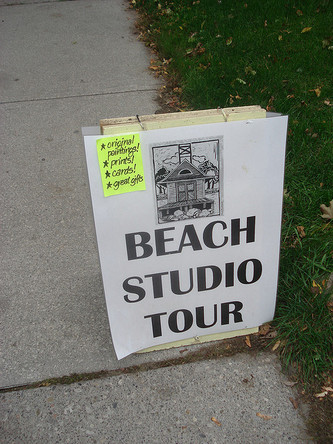 "Sign for Beach Studio Tour in 2007" image by Aasen Ryan Family (Pat & Keri) "Sign for Beach Studio Tour in 2007" image by Aasen Ryan Family (Pat & Keri) The signs may have changed since 2007, but " The Spring 2013 Beach Studio Tour in Toronto" continues delighting art lovers and casual browsers even in 2013. My article introduces the dates, times and geography, then links to the official web site for the specific details.
Update: the Beach Studio Tour of Fall 2013
It was so good, I went back to this topic in October 2013 for " The 2013 Fall Beach Studio Art Tour in Toronto". The details change each season for this semi-annual art tour, so it's worth checking.By the way, this writing tip still is true; especially as their official site does a fine job of explaining what's on. My big job is simply inviting readers to check them out.One Specific Writing Tip
One challenge in writing these annual Toronto event articles arises when there are a lot of details. The specific problem here is that there are 15 venues, 8 genres and 25 individual artists. It's painful to highlight a few, and redundant to copy all the information from the official site. It was a different situation with " The 2013 Khalsa Day Parade in Toronto long after Vaisakhi", because there was no one official web site and details were sparse. I dug into the reference material and presented the most cogent guide to this annual Sikh New Year parade in Toronto. (At least, I think it's the best summary). My specific writing tip for situations where the many details are already well handled by an official site is to let that site handle the minute details. Concentrate on the big picture. I explained where the core of the Toronto Beach Art Studio Tour would be, and how many venues were outside those boundaries. I also included the dates and times, since that was a short paragraph.You should do likewise. You might focus on one or two details that make the event interesting, or the "must-see" aspect of a tourist destination.But unless you're comparing two products feature by feature, you don't need to list every detail. Make art, not checklists; at least if you're covering a wide-ranging event like the Toronto Beach Art Studio tour.
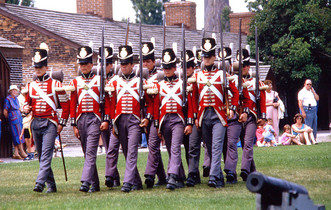 "Guarding Fort York in Toronto Ontario" image by Bobolink (Robert Taylor) The Battle of York, in the War of 1812, was an American victory over what is now the city of Toronto, Ontario, Canada. Nonetheless, Toronto takes notes of the anniversary as I report in " Commemorate the Battle of York in the War of 1812". My article highlights some of the events, including a sunrise event by members of several First Nations groups whose ancestors fought alongside the British colonists.The article notes other highlights, including a walking tour and a parade, both of which end at Fort York. My article links to the official City of Toronto web page for more details.
One Historic Writing Tip
Once again the writing tip is to keep your eyes open for topics in your niche.
In this instance, I happened to see an online ad for this day to commemorate the War of 1812 in Toronto's Fort York. In my opinion, the event was poorly advertised: it barely registered for me, and only because I'd previously written about annual events at Fort York.
Although I'm more inclined to write about annual events in Toronto than about a one-time ceremony, I felt this reminder of the Battle of York deserves its day in the sun.
 "Beaches International Jazz Festival Toronto 2007" image by beyond20khz (Josh Tidsbury) My latest DeHaan Services article about an annual summer event in Toronto is barely in time in mid-April. That's because the " Hennessy Talent Quest for Toronto Beaches Jazz Festival 2013" selects a winning band during April. So this online talent contest has become an annual spring event in Toronto, if only for the second year. It's a great opportunity for a band to perform at the prestigious and long-running Beaches Jazz Fest in Toronto in 2013.
One Jazzed-up Writing Tip
My article about the 2012 Toronto Beaches Jazz Festival was very popular, so I wanted to schedule the next as an article about an annual summer event in Toronto. To my surprise, the Hennessy Talent Quest 2013 was already taking place. This fit in perfectly with my mission to preview Toronto events, rather than reporting after the fact. So today's writing tip advises that you schedule your articles ahead of time. Check your sources early rather than at the last minute. This may give you the material for one or more bonus articles beyon
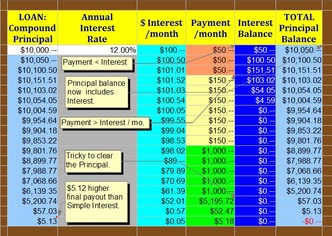 "Compound Interest Loan with Variable Repayments" : image by Mike DeHaan
 "Compound Interest Formula" : image by image by Mike DeHaan
One Writing Tip with Interest
This writing tip, like compound interest itself, builds on what has gone before.
It might have been possible to write one article about calculating interest.
However, it would have been longer than the Decoded Science ideal length.
It would also lose focus, especially for anyone looking for a really specific answer to either simple interest or compound interest.
There's no harm in writing a series of articles, unless you deliberately chop up one useful concept to increase the number of page views.
Conversely, readers who have to scroll through too many virtual pages, or click "next" seeking the elusive kernal of wisdom, are likely to give up in despair.
So the writing tip is to focus your article on one topic; cover it well; and write a series to cover the material that overflows the one-article-sized container.
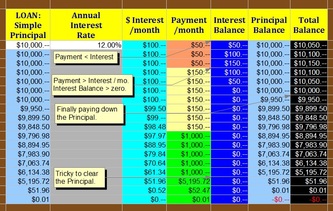 "Simple Interest Loan with Variable Repayments" : image by Mike DeHaan We're back with a new self-made image included in my recent Decoded Science article, " How to Calculate Simple Interest". Understanding how to calculate simple interest is a necessary skill for controlling your personal finances, since it lets you understand the cost of borrowing money. It's also the foundation for calculating compound interest, which is a future topic.Publishing my "artwork" here first establishes my copyright. I've also publicized my article in DeHaan Services, where " What is Simple Interest at Decoded Science" adds some Canadian content and recommends a simple reference book about personal finances.
A Simple versus Compound Writing Tip
Today we recycle an older writing tip based on my experience working on this article.
I'd originally considered writing about both simple and compound interest in one article. The main point would be the contrast between the two interest calculations.
Then I realized that each topic could easily fill an article or two. Even this "simple interest" essay had over 1,000 words.
Further topics could examine interest calculations for savings versus loans, or examine the relationship between Euler's "e=2.71828..." and compound interest.
So here is the double writing tip.
Break up your topic into manageable chunks, so you only present one unified concept at a time.
Do think about the range of sub-topics within your topic. Develop a series of articles to cover them.
That's my plan for the interesting topic of interest calculations.
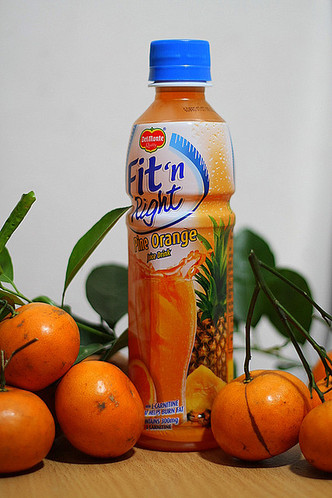 "Energy Drink with L-Carnitine" image by Coolm36 (Marcelino Rapayla Jr.) This single post must do double the publicity work for a pair of DeHaan Fitness articles today. I'd published " Another Kick at the Can of Soft Drinks and Soda Pop" on March 25, but was too busy to write a promotional article about the dangers of HFCS (high fructose corn syrup, known in Canada as sucrose-fructose). Yesterday, I found a news item concerning research into carnitine, naturally found in even the leanest red meat but also in some diet supplements for weight loss. Yesterday's news became today's " Possible Atherosclerosis Risks from Fat Burning Carnitine". My additional observation is that carnitine is promoted for the double role of a "burn fat and build muscle supplement".
A Common Source for Carnitine and HFCS
What do these two nutrients have in common?
Some energy drinks have both HFCS and L-carnitine. It's especially attractive if you want to boost your energy with muscle building supplements, and also as one of your fat burning foods.
The long-term risk with dietary carnitine is atherosclerosis. "What is atherosclerosis", you ask? Please read the appropriate article, above.
Meanwhile, HFCS carries other health risks, although they may also lead to atherosclerosis and its complications.
Publicity in DeHaan Services
Two Mindful Writing Tips
Today's first writing tip repeats something I've said before; the other may be new, or simply less frequently noted.
First, keep an open mind as you read your news sources. Both of the above articles were triggered by "new news"; but I was primed to noticed them because of previous research I'd done and articles that I'd written.
Second, develop a methodology to promote and publicize your articles. You don't need to write your own; but if all you do is tweet to followers or post updates on Facebook or Google+, then set up reminders to do so.
I log those publicity actions in a spreadsheet. The incomplete actions demand my attention, partly due to the colour difference as strong as "orange" versus "green". (Even if the "orange" text isn't very legible here in Weebly, you noticed the gap in the above sentence).
So although I was plenty busy over the last two weeks, there was no chance I would completely forget to finish publicizing the "kick at soft drinks" article. The reminder was right there, just above the "atherosclerosis and carnitine" one.
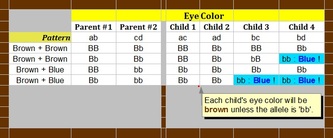 "Simple Baby Eye Color Predictor" : image by Mike DeHaan
One Clear-Eyed Writing Tip
When publisher and editor Victoria Nicks invited me to write this article, she suggested several potential topics although all dealt with "predicting the baby's characteristics".
When I suggested my ideas for three, she said "Oh no, just pick one".
I wrote about all three anyway, figuring that either it would be a lengthy article or we could split it up. I'd already done the research.
The clear-eyed writing tip is to either give your editor exactly what she requests, or be prepared to see your "masterpiece" after plastic surgery.
The better you know your editor, the closer you can predict the probability of her actions.
You'd have to read the article to decide whether you make more accurate predictions of baby eye colour, gender or height than I made about how my article(s) would fare.
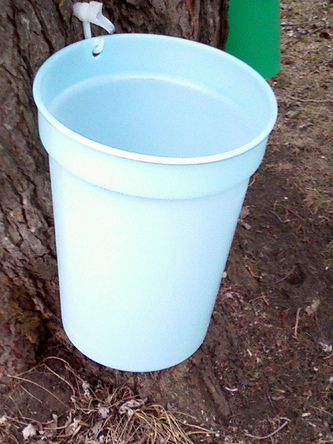 "Collecting Maple Sap for Maple Syrup" image by Bobolink (Robert Taylor)
One Sweet Writing Tip
I'd taken some notes about these maple syrup festivals a couple of weeks ago, but was busy with other writing tasks. These included events that would occur well before these festivals were scheduled to close. I also had the nagging feeling that I'd written about them already. However, my trusty logbook told me that they were still in line.That feeling was only resolved when I added the publicity for the article to my Squiddoo Lens of Annual Toronto Events. Aha! I'd written many of the details there, out of concern that I'd miss this year's opportunity for a feature article. My sweet writing tip today is to keep organized in a way that suits your work habits. Some people use sticky notes. Others would make a calendar with start dates and due dates for assignments. In this case, a tickle note in one document with the links to the sources was all I needed to make this article about maple syrup festivals in Ontario into a reality.
|
 "Sign for Beach Studio Tour in 2007" image by Aasen Ryan Family (Pat & Keri)
"Sign for Beach Studio Tour in 2007" image by Aasen Ryan Family (Pat & Keri) 








 RSS Feed
RSS Feed